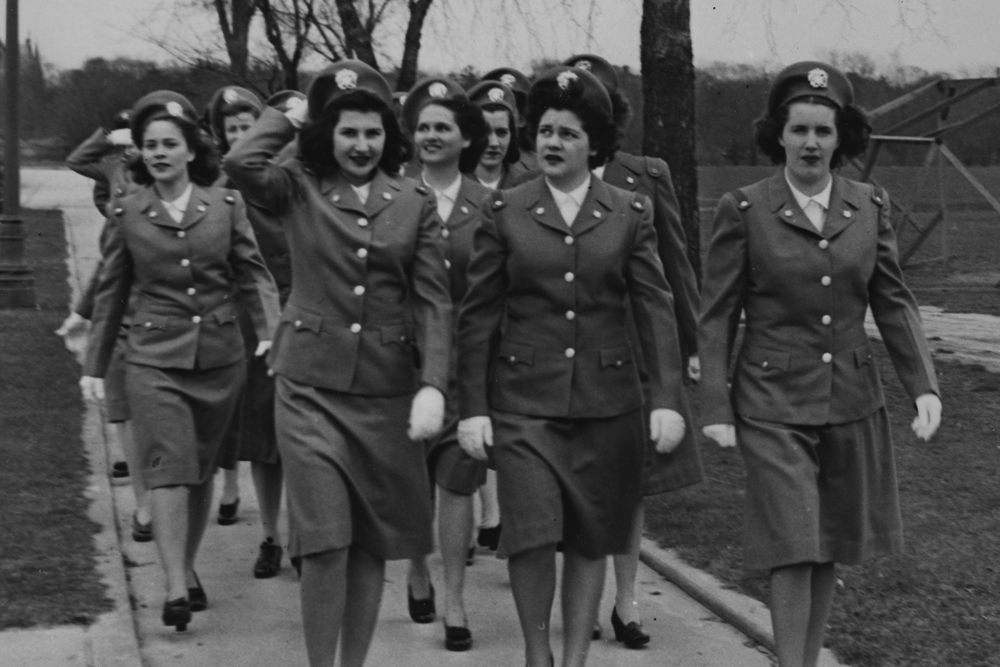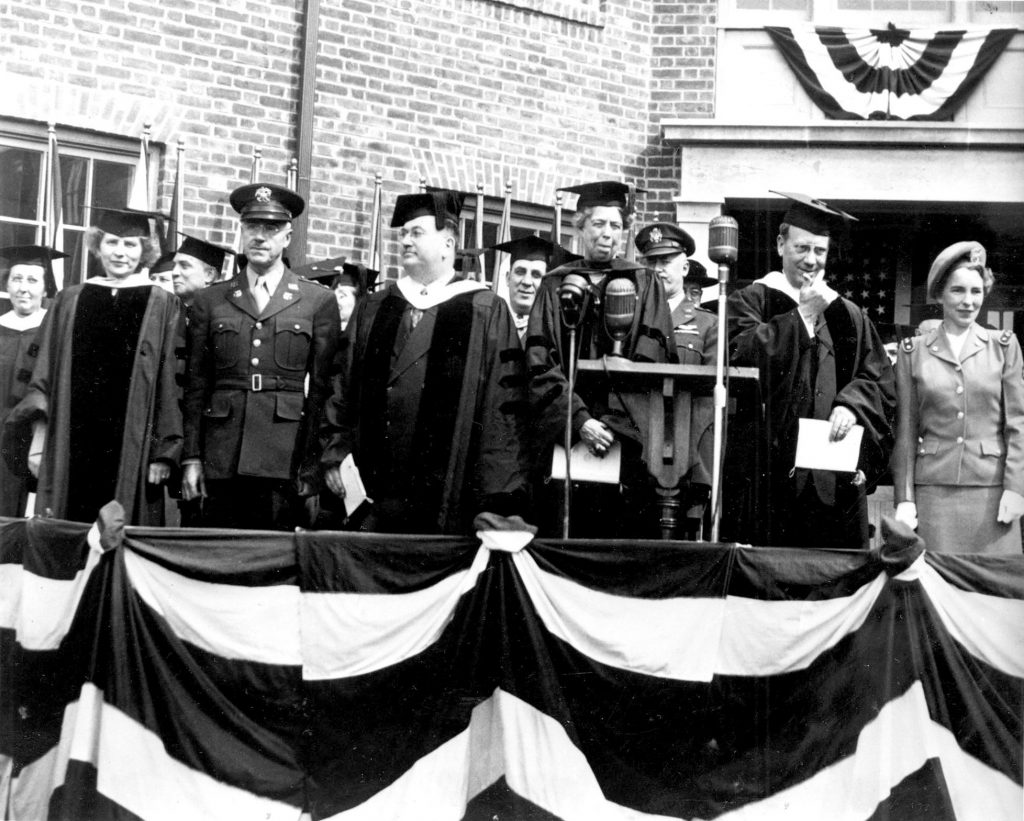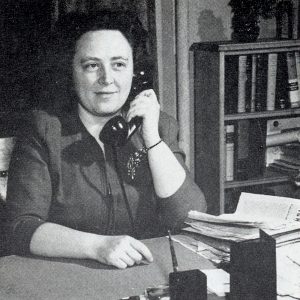Our History
We are building on more than 80 years of success.
With World War II raging, the country faced a dearth of nurses to treat wounded soldiers at home and abroad. Hence, through the Bolton Act, Congress funded training for nurses who joined the U.S. Cadet Nurse Corps at schools such as Adelphi. In February of 1943, Adelphi opened its nursing school with an enrollment of just under 30 women. By October of that year, 187 women were enrolled.

U.S. Cadet Nurse Corps at Adelphi.
The need for proper housing was immediately apparent. First-year nursing cadets—as they were known—either commuted to campus or lived in the Adelphi gym—the building that is now Woodruff Hall. Former dean Ruth S. Harley ’24, ’50 (Hon.) recalled in a 1979 interview that the 34 first-year cadets living in the gym referred to their quarters variously as Hopper-Haven, Bed-Side Manor and Grand Central.
Following the Depression, Adelphi was in debt, and paying for new student housing required creative financing. In her book, A History of Adelphi University (Boston: Pearson, 2014), Adelphi Professor of English Jennifer Fleischner, Ph.D., explains the scheme: Adelphi sold a plot of its mortgaged land to the Alumnae Association who then deeded it to the federal government for construction. Through the Lanham Act, administered by the Federal Works Administration, Adelphi secured two successive grants of $170,000 and $155,000 to build two residence halls to house 200 women. McKim, Mead & White—the renowned architectural firm that had designed Adelphi’s first three Garden City buildings (today’s Levermore, Blodgett and Woodruff halls)—designed the L-shaped dormitories with 50 rooms apiece as well as some administrative offices, recreation rooms and service rooms. East Hall, which was later renamed Alumnae Hall in honor of the Alumni Association, was completed first. West Hall, later dubbed Harvey Hall in honor of Anna E. Harvey, dean of Adelphi from 1922 to 1935, followed soon after.
On May 6, 1944, First Lady Eleanor Roosevelt joined College leaders and other dignitaries, including the U.S. Surgeon General, to dedicate the buildings. She said prophetically, “I am very glad that in a time of war we can dedicate a building which, while it is dedicated to war service now, will continue to be of service to this college and this community after the war is over.”

Dedication 1944: Eleanor Roosevelt (at the microphone) came to Adelphi in May 6, 1944 for the dedication of the school’s first two dormitories built for students from all over the country who came to help the war effort. Pictured from left to right are: Ruth Harley, Dean of Women, Surgeon General Thomas Parran, James E. Stiles, Chairman of the Adelphi Board of Trustees, Mrs. Roosevelt, Adelphi’s President Paul Eddy, and Lucille Petry, Director, U.S. Nurse Corps.
Dr. Betty L. Forest ’47, ’10 (Hon.), who was among the 4,000 audience members that day, recalled that “We wore our cadet nurse uniforms, and we learned to march!” She and her friends, who had been living in the gym, were “just tickled” to have the new quarters. Once the dorms were open, groups of young women could be seen carrying entire dresser drawers full of clothing across campus to their new rooms.
In a 2004 interview for A History of the Adelphi University School of Nursing—by Ellen (Krawiecki) Florentine ’86, M.S. ’04—Ann (Callahan) Dick ’47 recalled, “I missed Eleanor Roosevelt’s visit, but I heard so much about it, that I felt like I was there.” Dick moved into the dorms in September 1944 and said, “A week later, on the twelfth, we had a hurricane and the new roof leaked like a sieve.”
Dick vividly remembered the housemother, Mrs. Davis, a survivor of the battles of Bataan and Corregidor, who strictly enforced the evening curfew. “She was a tough old, chain-smoking nurse, but we loved her anyway.”
The 1956 Oracle yearbook is the last one in which students are listed as living in either Alumnae or Harvey Hall. The 1958 Oracle reported that Adelphi’s Institute of Health, Education and Welfare had been established in Alumnae Hall. (As its name implies, the institute offered graduate programs in a range of health-related areas, including nursing, social work and psychology.)
In 2015, with the opening of the Nexus Building became the home of the College of Nursing and Public Health.
Mildred Montag, PhD

Mildred Montag, PhD was the founder and director of the Adelphi College School of Nursing.
As founder and director of the Adelphi College School of Nursing from 1942 to 1948, Mildred Montag, PhD, developed the nursing program and was recognized for her impact on nursing education in the United States and throughout the world.
The United States’ entry into World War II resulted in an urgent need for nurses. In January 1943, Dr. Montag was named director of the School of Nursing, the first program for nursing on Long Island. The first 25 students were admitted under the Nurse Training Act of 1943, also known as the Bolton Act. After completing the program, most of the students joined the U.S. Cadet Nurse Corps.
Under Dr. Montag’s leadership, enrollment increased steadily. To accommodate the large number of students, Adelphi built Alumnae and Harvey Halls, two federally funded residence halls for women. Their opening in 1944 was marked with a ceremony attended by dignitaries including First Lady Eleanor Roosevelt, who delivered the address, “The Challenge of Nursing for Young Women Today.”
In 1948 Dr. Montag left Adelphi College to complete her doctoral studies at Columbia University Teachers College. Her doctoral dissertation, “The Education of Nursing Technicians,” was to influence profoundly the course of nursing education. Dr. Montag advocated the creation of an associate degree in nursing that would have a great impact on community college education for nursing.
Dr. Montag remained actively involved with Adelphi and received many honors. At the June 2000 Homecoming for the Class of 1930, she was remembered. In 2003 Dr. Montag was honored at the 60th anniversary of the Adelphi University School of Nursing and became the first member of the School of Nursing Hall of Fame. Her image is on the medal awarded to each honoree.
Initiating ADN Education
Associate degree education for nursing began as part of an experimental project at Teachers College, Columbia University, New York in the 1950s. In her doctoral dissertation, Dr. Montag proposed educating a technical nurse for two years to assist the professional nurse, whom she envisioned as having a baccalaureate degree.
Background Facts
Dr. Montag sought to alleviate a critical shortage of nurses by decreasing the length of the education process to two years and to provide a sound educational base for nursing instruction by placing the program in community and junior colleges. In 1958, the W.K. Kellogg Foundation funded the implementation of the project at seven pilot sites in four states.